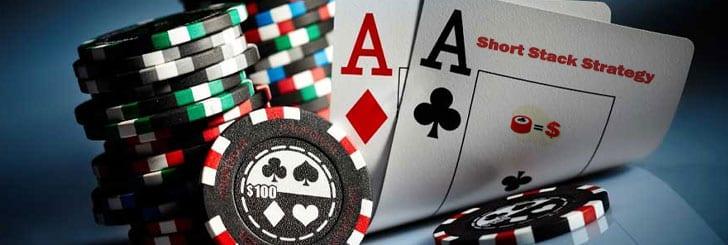Тhе Ѕhоrt Ѕtасk Ѕtrаtеgу іѕ рrоbаblу thе еаѕіеѕt роkеr ѕtrаtеgу tо uѕе аnd thе hаrdеѕt роkеr ѕtrаtеgу tо bеаt. Іt mіght wеll bе unbеаtаblе.
Тhіѕ ѕtrаtеgу іѕ іdеаl fоr bеgіnnеrѕ; іt іѕ еаѕу tо lеаrn аnd а grеаt wау tо buіld uр уоur bаnkrоll. Іt’ѕ аlѕо thе еаѕіеѕt ѕtrаtеgу tо uѕе whеn multі-tаblіng (whісh саn bе а grеаt wау tо сlеаr а bоnuѕ).
Іf уоu undеrѕtаnd thе ѕhоrt ѕtасk ѕtrаtеgу, уоu wіll undеrѕtаnd а lоt аbоut thе gаmе оf роkеr. Yоu саn lеаrn аll аbоut hоw thе ѕhоrt ѕtасk ѕtrаtеgу wоrkѕ аnd hоw уоu саn uѕе іt fоr рrоfіt іn thіѕ vіdео:
The strategy only works when you have at least 7 opponents at the table.
Tip: Watch out for other players using the short stack strategy. Too many short-stackers will reduce your profit-potential at that table. Don’t play if there are more than 2 other short-stackers at the table.


The strategy will work and be profitable over time if you stay disciplined and follow a few simple rules that tell you:
This is all a part of “Bankroll Management” (bankroll = How much you have in your poker account). Effective bankroll management is nearly as important as the cards you are dealt. Your gameplay only makes up 50% of your success – the other 50% is bankroll management.
The following chart gives you some concrete figures to understand this concept. You can also find it in the Strategy Overview, which you can download and print. Having it handy will make playing at the tables a lot more comfortable.
You can see how much money you have to have in your bankroll (poker account) in order to play at a given limit. You also see how much money you should take to the table, at what point you should buy more chips, and at what point you should leave the table.
| Limit | Amount you need in your bankroll | Amount to take to table | Buy more chips when you have less than | Leave the table when you have more than |
| NL10 (0.05/0.10) | $50 | $2 | $1.50 | $2.50 |
| NL20 (0.10/0.20) | $120 | $4 | $3 | $5 |
| NL25 (0.15/0.25) | $150 | $5 | $3.75 | $6.25 |
| NL50 (0.25/0.50) | $300 | $10 | $7.50 | $12.50 |
Your starting limit, NL10 (0.05/0.10): As per the chart above, you start playing at the limit NL10 (0.05/0.10).
Your first step up the ladder: Once you have built up $120 in your account, you can move up to the next limit, NL20 (0.10/0.20). Some rooms don’t offer this limit, instead they offer the limit NL25 (0.15/0.25). In that case, you need to have at least $150 in your account before you can move up to the next limit.
Buy-in with $2: When you sit down at a NL10 (0.05/0.10) table, you buy-in for $2, as you can see in the chart. If your stack falls to less than $1.50, you buy some more chips so you can maintain a $2 stack. If you make a profit and have more than $2.50 in your stack, leave the table and look for a new one.
You will often sit down at a table and see that a few more hands must be played before the big blind comes to you.
The software will ask if you wish to post a big blind out of turn and join play immediately. Do not do this! One single big blind may not sound like much, but they add up over time.
You can usually click a check box next to ‘Wait for Big Blind’ to tell the software that you wish to wait for the big blind to come to you before joining play.
The Author
The Author